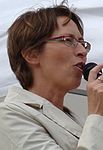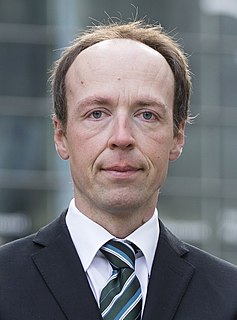The Green League, shortened to the Greens, is a green political party in Finland. The Green League is among the largest political parties in Finland. The Greens hold fifteen seats in the Finnish Parliament and one in the European Parliament. The party is a member of the Global Greens and the European Green Party, while its MEP, Heidi Hautala, sits with The Greens–European Free Alliance in the European Parliament. Originally split on whether Finland should join the European Union, the Green League is pro-European and was the first Finnish party in favor of the federalisation of the European Union.
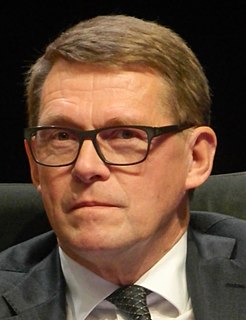
Matti Taneli Vanhanen is a Finnish politician who was Prime Minister of Finland from 2003 to 2010. He was also Chairman of the Centre Party, and in the second half of 2006 he was President of the European Council. In his earlier career he was a journalist. Vanhanen is the son of professor Tatu Vanhanen and Anni Tiihonen.

Cai-Göran Alexander Stubb is a Finnish politician who served as the Prime Minister of Finland from 2014 to 2015. He rose to politics as a researcher specialized in the affairs of the European Union and was elected to the European Parliament in 2004 as a member of the National Coalition Party. In 2008, Stubb was appointed as Minister for Foreign Affairs following a scandal surrounding his predecessor, Ilkka Kanerva. In 2011 Stubb stood for election to the Finnish Parliament for the first time and was elected MP with the second highest vote count in the election, which led to Stubb becoming the Minister for Europe and Foreign Trade in Jyrki Katainen's cabinet.
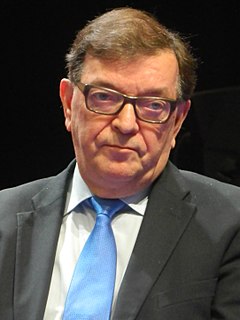
Paavo Matti Väyrynen is a Finnish veteran politician and a member of the Finnish Parliament, representing the Seven Star Movement and formerly the Citizen's Party and Centre Party. Väyrynen has been a member of the Finnish Parliament previously from 1970 to 1995 and again from 2007 to 2011 and has held many ministerial portfolios. He has also been a Member of the European Parliament from 1995 to 2007, and again from 2014 to 2018.
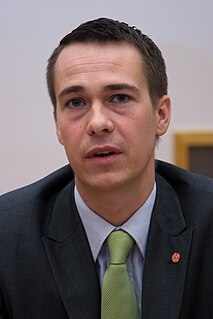
Carl Christoffer ”Calle” Haglund is a Finnish politician, former chairman of the Swedish People's Party and the former Minister of Defence. He was member of the European Parliament (MEP) from 2009 to 2012. Haglund was elected chairman of his party in June 2012.

Sampo Terho is a Finnish politician and the current Minister for European Affairs, Culture and Sports. He is the chairman of Suomalaisuuden Liitto and was earlier a Member of the European Parliament.
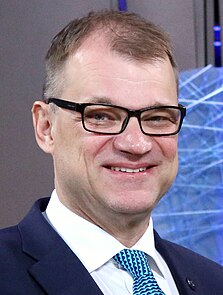
Juha Petri Sipilä is a Finnish politician who has served as Prime Minister of Finland since 2015. A relative newcomer to politics, he has a successful background in business. He has been the leader of the Centre Party since 9 June 2012. After leading the Centre party to victory in the 2015 general election, Sipilä formed a centre-right coalition and was appointed Prime Minister by the Finnish Parliament on 29 May 2015. On 8 March 2019, Sipilä stated his intention to resign as Prime Minister, citing difficulties in reforming Finland's health care system. President Sauli Niinistö has asked him to continue with a caretaker government until a parliamentary election can be held on April 14.

The 2015 Finnish parliamentary election was held on 19 April 2015, with advance voting from 8 to 14 April. The 200 members of eduskunta were elected with the proportional D'Hondt method.

Antti Petteri Orpo is a Finnish politician, chair of the National Coalition Party and the incumbent Minister of Finance. Previously he served as the Minister for Agriculture and Forestry 2014–2015 and Minister of Interior 2015–2016.

The cabinet of Juha Sipilä was the 74th government of Finland. It was formed following the parliamentary election of 2015 and formally appointed by President Sauli Niinistö on 29 May 2015. Since June 2017, the cabinet has consisted of a coalition formed by the Centre Party, Blue Reform and the National Coalition Party. The cabinet's Prime Minister was Juha Sipilä.

Presidential elections were held in Finland on 28 January 2018. The incumbent Sauli Niinistö received 62.7% of the vote and was elected for a second term, avoiding a second round. The term will be from 1 March 2018 to 1 March 2024. Although the President is elected by direct election, Niinistö gained a plurality in all municipalities and a majority in all but 13 municipalities. The next most popular candidate and Niinistö's most popular competitor in the previous elections in 2012, Pekka Haavisto, received 12.4% of the vote.

The National Coalition Party leadership election, 2016 was held in Lappeenranta, Finland on June 11, 2016 to elect the chair of the National Coalition Party. In the election, Alexander Stubb, the incumbent party chair and Minister of Finance, was defeated by Petteri Orpo, the Minister of the Interior. Elina Lepomäki, a Member of the Parliament, finished third. After the leadership election, Orpo took Stubb's post as the Minister of Finance.

The 2017 Finns Party leadership election was held in Jyväskylä, Finland, on June 10, 2017, to elect the new chair of the Finns Party. All members of the party who had paid their subscription were allowed to vote in the election.

Miika Sebastian Tynkkynen is a Finnish politician. He has been chairman of the Finns Party Youth and third vice chairman of the Finns Party.
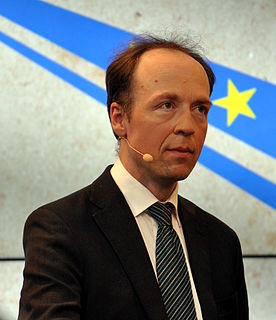
The 2017 Finnish government crisis followed the Finns Party leadership election held on 10 June 2017. Prime Minister Juha Sipilä and Minister of Finance Petteri Orpo announced on 12 June that they would no longer cooperate in a coalition government with the Finns Party after Jussi Halla-aho was elected party chairman. The crisis resolved on 13 June when twenty MPs defected from the Finns Party's parliamentary group, forming what would eventually become the Blue Reform party. Sipilä's government retained a majority in Finland's parliament as the Blue Reform continued as a member of the coalition.

Blue Reform is a Finnish conservative political party.

Leena Kristiina Meri is a Finnish politician, representing the Finns Party in the Parliament of Finland. She has served in the Parliament since 2015 and in the City Council of Hyvinkää since 2013.








